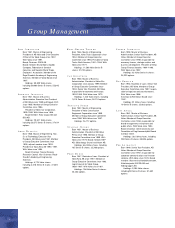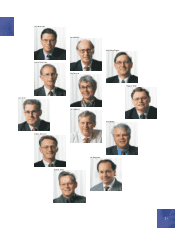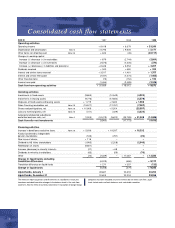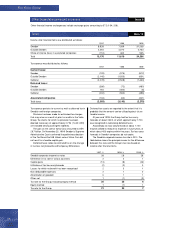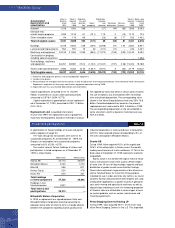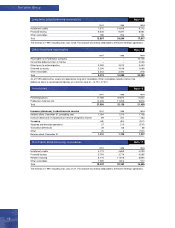Volvo 1999 Annual Report Download - page 62
Download and view the complete annual report
Please find page 62 of the 1999 Volvo annual report below. You can navigate through the pages in the report by either clicking on the pages listed below, or by using the keyword search tool below to find specific information within the annual report.
The Volvo Group
60
Parent Company holdings of share in subsidiaries as of
December 31, 1999 are shown on pages 94–95.
Significant acquisitions, formations and divestments
within the Group are shown below.
Volvo Maquinaria de Contruccion Espana SA
As part of the strategy to mainly organize sales through
independent dealers, Volvo Construction Equipment divest-
ed its market company in Spain in the second quarter of
1999. The buyer was Auto Sueco Lda, which previously
was Volvo’s partner in Portugal for more than 50 years.
The gain from the sale amounted to SEK 0.2 billion.
Pro-Pav and Superpac
In April 1999, Volvo Construction Equipment reached an
agreement covering the sale of its operations under the
trademarks Pro-Pav and Superpac. The operations were
previously conducted within the Canadian subsidiary
Champion Road Machinery.
Mecalac
In March 1999, Volvo Construction Equipment divested
65% of its operations involving compact machinery under
the Mecalac brand name. Concurrently, the intention to
divest the remaining 35% interest within three years was
announced.
Jet Support Corporation
As a result of the agreement between Volvo Aero and
Boeing that grants Volvo Aero exclusive rights to market
and to sell surplus spare parts to the fleet of Boeing air-
craft on the world market, primarily to aircraft types that
are no longer manufactured, the operations of American
Jet Support Corporation were acquired in April 1999.
Volvo Aero Norge AS (formerly Norsk Jetmotor AS)
During 1999, Volvo Aero acquired 78% of the shares in
Norsk Jetmotor AS in two stages for NOK 240 M. In
conjunction with the acquisition, the name of the com-
pany, which is mainly involved in production of com-
mercial aircraft components, was changed to Volvo Aero
Norge AS. Goodwill of SEK 0.1 billion that arose in con-
junction with the acquisition is being amortized over 20
years.
Volvo Malaysia Sdn Bhd
In the beginning of 1999, Federal Auto Industrial Sdn Bhd
was acquired. The company, whose name was changed
later in the year to Volvo Malaysia Sdn Bhd, conducts
importer and dealer operations in Malaysia for trucks and
buses as well as marine and industrial engines.
Volvo Cars
In January 1999, AB Volvo reached an agreement with
Ford Motor Company covering the sale of Volvo Cars.
Following approval by a General Meeting of Volvo share-
holders on March 8, and by the relevant competition
authorities, AB Volvo completed the sale of Volvo Cars to
Ford Motor Company on March 31, 1999. Under terms
of the agreement, Ford has the right to Volvo Cars’ earn-
ings beginning on January 1, 1999. In addition to a divi-
dend of SEK 17.7 billion from Volvo Personvagnar
Holding AB, AB Volvo received SEK 10.3 billion for the
shares, plus USD 2.3 billion, of which USD 1.6 billion will
be paid on March 31, 2001. In connection with the sale,
Ford assumed financial net debt of SEK 4.8 billion. The
gain from the sale amounted to SEK 26.7 billion. In con-
junction with the sale of Volvo Cars, the Volvo trademark
was transferred to a newly formed company named
Volvo Trademark Holding AB which is owned jointly by
AB Volvo and Volvo Car Corporation. The right to use the
trademark is thereby governed by a license agreement
between Volvo Trademark Holding AB and AB Volvo as
well as Volvo Car Corporation.
Mexicana de Autobuses SA de CV
In October 1998, AB Volvo acquired all of the shares
of Mexicana de Autobuses (MASA). MASA is Mexico’s
second-largest producer of tourist and intercity buses.
Goodwill amounting to SEK 0.6 billion, which is being
amortized over 20 years, arose in connection with the
acquisition.
Acquisitions and divestm ents of shares in subsidiaries Note 2
Definition of key ratios
Operating margin
Operating income divided by net sales.
Return on operating capital
Operating income divided by average operating capital.
Operating capital consists of operating assets (tangible and
intangible assets, receivables and inventories) reduced by
noninterest-bearing current liabilities. This ratio is used only
for Volvo’s business areas, not for the Group as a whole.
Return on shareholders’ equity
Net income divided by average shareholders’ equity.
Interest coverage
Income divided by interest expense and similar charges.
Income includes operating income, income from invest-
ments in associated companies, income from other
investments and interest income and similar credits.
Self-financing ratio
Cash flow from operating activities (see Cash flow
analysis) divided by net investments in fixed assets and
leasing assets.
Net financial assets (net debt)
Cash and bank accounts, marketable securities and
interest-bearing short- and long-term receivables reduced
by short- and long-term interest-bearing loans. Net debt in
Volvo’s sales-financing companies is not included since
the interest expense on these liabilities is charged against
operating income and does not affect consolidated
interest net.
Share of shareholders’equity and minority interests
Shareholders’ equity and minority interests divided by
total assets.
Share of shareholders’ equity
Shareholders’ equity divided by total assets.
Income per share
Net income divided by the weighted average number of
shares outstanding during the period.




